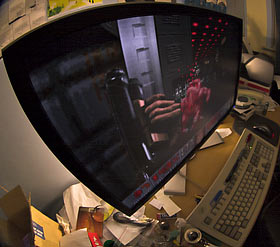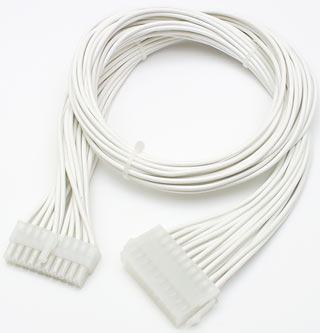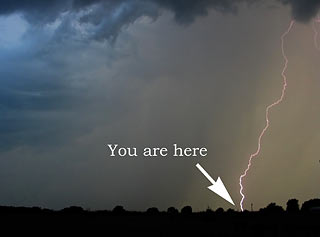
Atomic I/O letters column #92
Originally published 2008, in Atomic: Maximum Power ComputingReprinted here March 24, 2009 Last modified 16-Jan-2015.
The electrons get lost
I came upon this article while wandering on the net. It's the last entry I'm referring to - is it really possible to protect gear against a lightning strike by tying knots in power cords?
Bob
Answer:
No, not really.
Apparently, a knotted cable subjected to a lightning-right-outside surge will blow apart and pass very little current, proportionally speaking, to whatever it's plugged into. If you seriously believe, however, that enough power to actually explode the power cable will not have any deleterious effect on the hardware which until recently was plugged into what is now a cloud of PVC and copper vapour, then I've got a lovely bridge to sell you.
Lightning definitely does do some very peculiar things, and I can certainly believe that a monster discharge could miss, or hit, valuable hardware depending on the physical configuration of the supply cable. If, for instance, you wind a power lead around a metal sink drainpipe a couple of times, a lightning discharge into that cable will probably punch through the insulation and go to ground that way, rather than take the longer and narrower path through the thing the cable's powering. There are many anecdotal accounts of things like this happening.
But just because the bulk of the energy shoots to ground some other way does not mean that there won't still be a very large - by domestic standards - spike in the voltage the equipment sees. Knots or other humungous-zap-catchers will probably only stop energy above threshold X from being seen by the powered device, and threshold X may be more than enough to destroy the device. As I've explored before, even a weedy lightning strike can be expected to have a total energy in the neighbourhood of a billion joules; if one way or another 99.999% of that energy goes somewhere other than into your computer, your poor PC will still be trying to deal with the energy of six shots from an Ahnie-gun.
So using knots as your only protection against lightning strikes is unlikely to do any good. It may give you a "lightly scorched" dead computer instead of a "blown apart" one, but this is not a big advantage. I suppose it might be worth doing as a first line of defence, though - for the power cable that goes to your power conditioner, say.
Note that the energy levels we're talking about here mean you're probably going to have to have the building rewired afterwards. If lightning strikes anything connected to your house's electrical wiring, it's probably going to be expensive.
Tying knots doesn't do any harm, though. So by all means give it a go if you like.
I mentioned this in passing in my old piece about power conditioning.
Religious differences
Why is it that Linux still has only very dodgy NTFS support out of the box? You don't get write support unless you download the 3G driver, and you don't get ACL support at all (or if you do, then I haven't experienced it).
Is it just that nobody cares enough to spend the effort, or is Microsoft actively trying to prevent NTFS support on Linux?
Nathan
Answer:
The NTFS filesystem is not an open format. As with various other Microsoft-developed
formats (Rich Text Format,
for instance, is best defined as "what Word saves when you tell it to save as RTF"...),
the only way to get other systems to deal with it is to reverse-engineer it. And yes,
Microsoft might well get in the way of this process, if they think your reverse-engineering
looks suspiciously like just decompiling bits of the Windows kernel and saying it's
yours.
Since NTFS has a lot of features, and hasn't even been the standard Windows filesystem until the Win95 line died out, relatively little progress has been made. People with the chops to reverse-engineer filesystems are likely to be more interested in writing their own.
(Actually, in the time between when I first sent this answer to Nathan and when this letters column was republished here, it's become possible to get Linux distros that have half-decent read/write NTFS support as standard. It's not absolutely 100% cooked yet - if, for instance, you shut down without dealing with any filesystem errors, Annoying Things will apparently happen when you start up again - but it's definitely improving, closed standard or no closed standard. A reader's also brought ntfsprogs to my attention, which lets other Linux distributions mount NTFS volumes pretty much like any other filesystem.)
Sword-fighting is nothing without insults
I recently went forth and bought a new computer (quad-core, ATI video card). I'm currently running 64-bit Vista to take advantage of extra RAM, as my work revolves around 3ds Max, Photoshop, Illustrator and Revit.
But sometimes I like to take time off from work and play. But running 64-bit Vista causes issues: Monkey Island 3 won't work!!
Is there a workaround you're aware of? Or will I need to bite the bullet and go down the dual-boot path just to play one game? (I did a little rummaging on Google and found a patch for Monkey Island, but is there a workaround so I don't need to constantly do this?)
Tristram
Answer:
If turning on all of the compatibility options in the Properties for a DOS-era game
don't get it working in Vista (or in XP, for that matter), your next stop should be
DOSBox.
DOSBox is a free emulator which looks, to software running in it, like an MS-DOS PC with all of the add-ons that people had to spend forever setting up in the DOS days. It was specifically created to run old games on new PCs, and yes, it even works on 64-bit Vista.
(Shame on me! After this page went up, more than one reader pointed out to me that Monkey Island 3 is actually a Windows game, since it came out in 1997. It's still not difficult to get running on modern Windows versions, though, since it uses the SCUMM engine, and can therefore be played via ScummVM on current PCs. As I write this, Monkey Island 3 {"The Curse of Monkey Island"} is listed on the ScummVM compatibility page as "90%" compatible, with "no known issues".)
Resolution wrangling
I recently bought myself an Acer X173w monitor, with a native resolution of 1440x900. I like this monitor, but the big resolution compared to my old CRT's 1024x768 makes gaming less fun. Better image quality, yes, but less frames per second.
I tried lowering the resolution to 1280x800 and 960x600, but the image displayed is ugly.
As far as I know, the only other resolution that can be clearly displayed with this monitor is 720x450, not counting the lower ones. That should be smooth enough for me, as it is very close to NTSC DVD resolution. The problem is, I can't seem to find any way to run any game in that resolution, and it will be quite a while before I can afford a new graphics card.
I have to admit that this is not a serious problem. Turning off some pretty settings helps nicely. But I just keep wondering about this. Can you help me here?
Andhika

320 by 200 maps perfectly onto 2560 by 1600!
Answer:
Yeah, 1440 by 900 is indeed a tough resolution to halve (or quarter, depending on whether
you look at it linearly or by area).
The solution is as obvious as it is simple: Merely purchase a 30-inch 2560-by-1600 screen, and you'll now be able to run games at decent speed in the standard 1280-by-800 resolution!
If for some reason this solution doesn't appeal to you, all I can suggest is that you try fiddling around with a video-card-tweaking program like EnTech's famous PowerStrip. That ought to let you set your monitor to any resolution that your video subsystem can actually generate. But it probably won't, in this case, work.
720 by 450 is, I think, very seldom seen as a standard PC resolution. It's below the 800-by-600 minimum for Windows XP, for a start. But it's not that outlandish. It appears as a standard resolution in various Linuxes and also Mac OS, I think.
Note that running an LCD monitor at half of its native resolution each way won't really give a "smooth" result; instead, it'll just lay one image pixel over each four monitor pixels, making "jaggy" lines considerably coarser. To smooth them out, you'd have to use Full Scene Anti-Aliasing, which would increase the load on the video card and somewhat defeat the purpose.
I don't mind the look of LCD half-res, myself; it's only really a problem if you're playing a sniper or something and so need a ton of resolution. But you may find that the fuzzy-scaled look of intermediate resolutions isn't really that bad in comparison.
(In the olden days, LCD monitors either used hideous blocky nearest-neighbour interpolation to scale lower resolutions up to cover the full screen, or they just left a black border around the edge. I don't think it's possible to buy a monitor that doesn't do some smoother kind of interpolation any more, though. Many monitors these days are "dumb", however; they actually make the video hardware do the scaling, so the graphics card actually sends them a full-resolution image all the time. If that's the case, you may once again find that dropping the resolution doesn't give you as much of a speed boost as you'd hoped.)
Pins 1 through 47: +5V
PATA (ultra ATA etc) cables have 40 pins, and the plug and cable are 60mm or so wide. Big wide fat cable and plug.
SATA cables have 7 pins, the plug is about 13mm wide, the cable about 8mm. Big improvement.
However, PATA power cables (aka Molex connectors, although that's a bit of a misnomer) have 4 pins, 23mm or so wide. While SATA power cables have... 15 pins, 23mm wide. Hmmm.
Why no decrease in connector size, and why the increase in pin count?
The 15 pins are fed by the same 4 wires that feed the 4 pin PATA cable (which strictly speaking could be 3 wires, since 2 of them are ground).
Checking the spec, each SATA-power voltage has like 3 pins, all of which are coming from the same cable anyway.
(OK, they added optional pins for 3.3V which isn't in the PATA cable, but they gave that 3 pins too, not to mention 6 pins for ground!)
What gives?
Is it simply to make the power plug "different from the data cable" so that idiots can't plug them in the wrong socket?
Tim

Real men tell the wires apart by flavour.
Answer:
I think the multiplicity of pins is just to get lower losses from resistance. The wires
in SATA power leads are pretty small-gauge, and the terminal connectors are very small
too. So they just connect the same rail of the PSU to multiple wires that run in parallel,
which means each individual wire has to carry less current.
Many other computer power leads do the same sort of thing. A standard old-style 20-pin ATX connector, for instance, has three +3.3V wires, four +5Vs (not counting the single 5V standby wire), and seven earths. The dual earths in "Molex" power leads are there for the same reason.
(And you don't, of course, have to be an idiot to occasionally plug something into a connector that's the right shape, but not the right socket. Everybody's plugged a PS/2 mouse into the keyboard socket and vice versa; when you're folded up under a desk slicing your arm up in a cheap PC case and trying to wrestle a new cable into place around all of the other ones, power connectors that look like some other kind of connector are an invitation to disaster, no idiocy required. On which note, may I present the three-pin XLR or "Cannon" connector, which is still commonly used for balanced audio interconnects, but also used to be used for mains power!)


